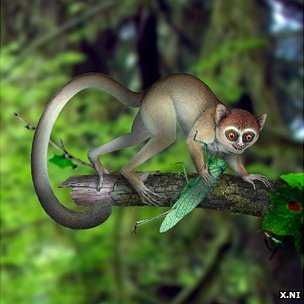Welcome to DU!
The truly grassroots left-of-center political community where regular people, not algorithms, drive the discussions and set the standards.
Join the community:
Create a free account
Support DU (and get rid of ads!):
Become a Star Member
Latest Breaking News
General Discussion
The DU Lounge
All Forums
Issue Forums
Culture Forums
Alliance Forums
Region Forums
Support Forums
Help & Search
Science
Related: About this forumTiny Chinese Archicebus fossil is oldest primate yet found
A mouse-sized fossil from China has provided remarkable new insights into the origin of primates.
At 55 million years old, it represents the earliest known member of this broad group of animals that includes humans.
Scientists have called the diminutive creature Archicebus, which roughly translates as "ancient monkey".
They tell Nature magazine that its skeleton helps explain the branching that occurred at the very base of the primate evolutionary tree.
http://www.bbc.co.uk/news/science-environment-22770646
InfoView thread info, including edit history
TrashPut this thread in your Trash Can (My DU » Trash Can)
BookmarkAdd this thread to your Bookmarks (My DU » Bookmarks)
3 replies, 1031 views
ShareGet links to this post and/or share on social media
AlertAlert this post for a rule violation
PowersThere are no powers you can use on this post
EditCannot edit other people's posts
ReplyReply to this post
EditCannot edit other people's posts
Rec (7)
ReplyReply to this post
3 replies
 = new reply since forum marked as read
Highlight:
NoneDon't highlight anything
5 newestHighlight 5 most recent replies
= new reply since forum marked as read
Highlight:
NoneDon't highlight anything
5 newestHighlight 5 most recent replies
Tiny Chinese Archicebus fossil is oldest primate yet found (Original Post)
dipsydoodle
Jun 2013
OP
Archicebus achilles is still an N-times removed cousin, not a great^Nth grandparent.
DreamGypsy
Jun 2013
#3
Judi Lynn
(160,527 posts)1. Thanks! n/t
G_j
(40,367 posts)2. a 55 million year old primate!
[URL= .html][IMG]
.html][IMG] [/IMG][/URL]
[/IMG][/URL]
DreamGypsy
(2,252 posts)3. Archicebus achilles is still an N-times removed cousin, not a great^Nth grandparent.
From the story in Nature:
(emphasis mine)
The near-complete fossil of a tiny creature unearthed in China in 2002 has bolstered the idea that the anthropoid group of primates — whose modern-day members include monkeys, apes and humans — had appeared by at least 55 million years ago. The fossil primate does not belong to that lineage, however: it is thought to be the earliest-discovered ancestor of small tree-dwelling primates called tarsiers, showing that even at this early time, the tarsier and anthropoid groups had split apart.
<snip>
The slender-limbed, long-tailed primate, described today in Nature1, was about the size of today’s pygmy mouse lemur and would have weighed between 20 and 30 grams, the researchers estimate. The mammal sports an odd blend of features, with its skull, teeth and limb bones having proportions resembling those of tarsiers, but its heel and foot bones more like anthropoids (hence, the species name 'achilles'). “This mosaic of features hasn’t been seen before in any living or fossil primate,” says study author Christopher Beard, a palaeontologist at the Carnegie Museum of Natural History in Pittsburgh, Pennsylvania.
<snip>
The size and shape of the primate's teeth — particularly the sharply pointed premolars, which were well adapted for shearing prey — strongly suggest that the tiny mammal fed mostly on insects. Such prey would have been abundant, because A. achilles evolved during an era when global temperatures were exceptionally high and jungles stretched as far north as the Arctic. “It was a great time to be a primate,” says Beard.
Because A. achilles sits near the base of the tarsier family tree, scientists say it probably resembles the yet-to-be-discovered creatures that lie at the base of most primate groups — including the anthropoid lineage that ultimately gave rise to humans. “If you retrace primate evolution to its beginning, [A. achilles] is what our ancestors most likely looked like,” says Luo.
<snip>
The slender-limbed, long-tailed primate, described today in Nature1, was about the size of today’s pygmy mouse lemur and would have weighed between 20 and 30 grams, the researchers estimate. The mammal sports an odd blend of features, with its skull, teeth and limb bones having proportions resembling those of tarsiers, but its heel and foot bones more like anthropoids (hence, the species name 'achilles'). “This mosaic of features hasn’t been seen before in any living or fossil primate,” says study author Christopher Beard, a palaeontologist at the Carnegie Museum of Natural History in Pittsburgh, Pennsylvania.
<snip>
The size and shape of the primate's teeth — particularly the sharply pointed premolars, which were well adapted for shearing prey — strongly suggest that the tiny mammal fed mostly on insects. Such prey would have been abundant, because A. achilles evolved during an era when global temperatures were exceptionally high and jungles stretched as far north as the Arctic. “It was a great time to be a primate,” says Beard.
Because A. achilles sits near the base of the tarsier family tree, scientists say it probably resembles the yet-to-be-discovered creatures that lie at the base of most primate groups — including the anthropoid lineage that ultimately gave rise to humans. “If you retrace primate evolution to its beginning, [A. achilles] is what our ancestors most likely looked like,” says Luo.
Here is the BBC representation of our relationship to the newly recognized Achilles:

Thanks for the post, dipsydoodle.